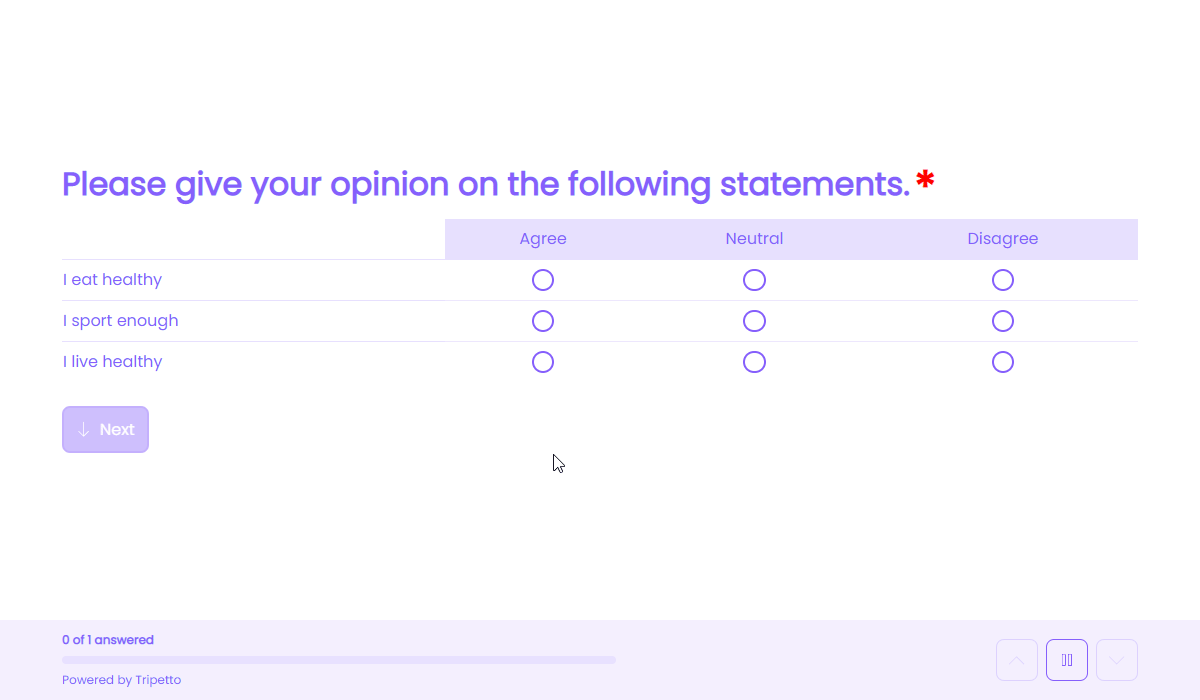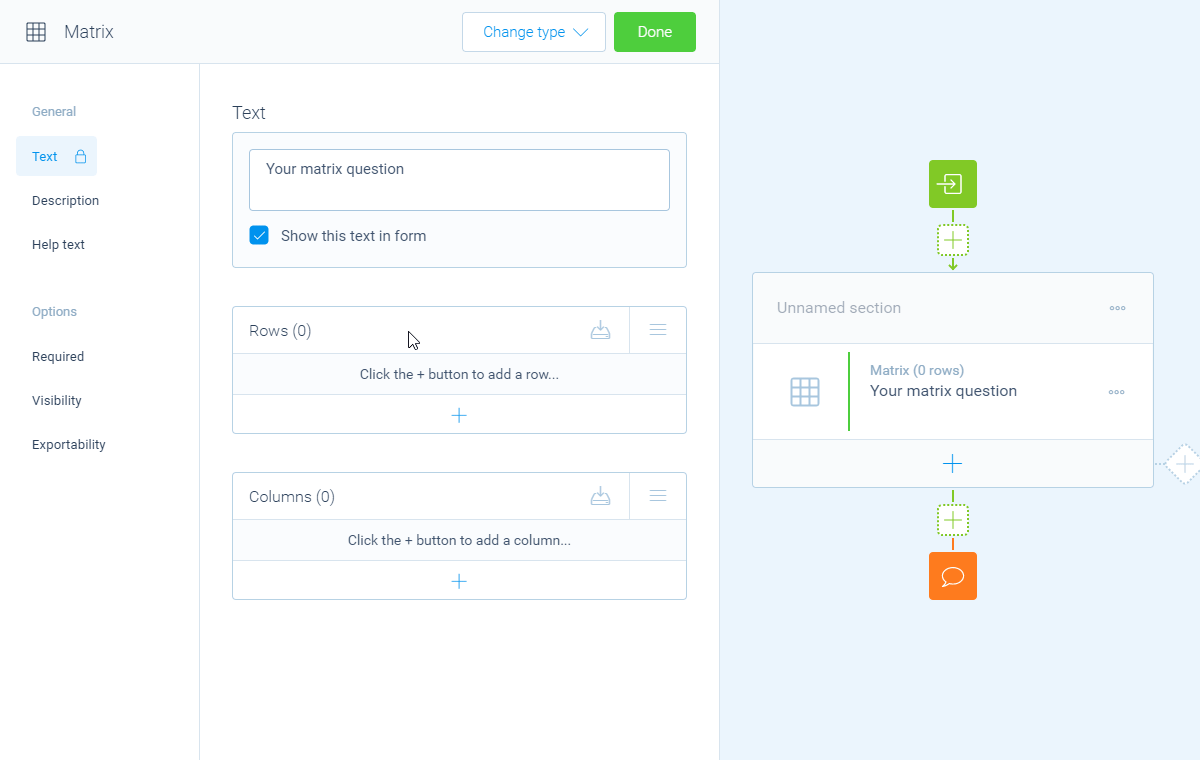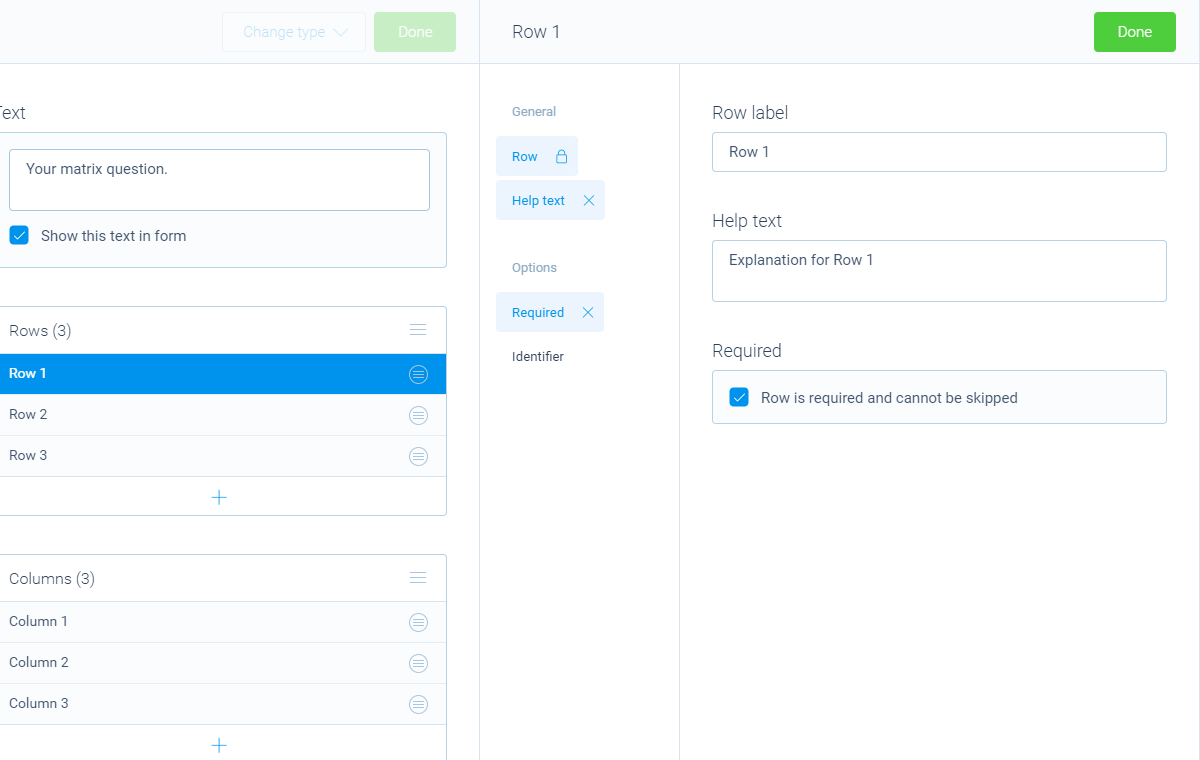How to use the matrix block
Learn everything you need to know to use the matrix block in your forms.
When to use
Use the matrix block to let your respondents choose from a set of options (columns) for multiple questions/statements (rows).

How to use
Add a new block to your form and then select the question type Matrix. You can now customize this block to your needs with the following features:
General
- Text
Use theTextfeature for the name/title of this block. - Description
Enable theDescriptionfeature to add a description to this block. - Help text
Enable theHelp textfeature to add a help text to this block.
Options
- Required
By default this block is not required to fill out by your respondents. Enable theRequiredfeature to make this block required to fill out. - Visibility
By default this block is visible in your form. Enable theVisibilityfeature to hide it for your respondents. - Score
You can attach scores to the choices to perform instant calculations. Enable theScorefeature to enter the desired score values. - Exportability
By default the collected data of this block will be stored to the dataset of each result. Enable theExportabilityfeature to take control over the storage. You can then include/exclude the data from your dataset. Please note that if you exclude data from the dataset you can never see and/or use the given answers from your respondents to this block, because the data is simply not stored at all.
Rows
Next, you can enter the list of rows that you want to show to your respondents:
- Add rows one by one
Click theicon at the bottom of the list and enter the row name. - Import a list of rows
Click theicon at the top of the list. Now supply a list with one row name per text line and clickImportto add them all at once to your list of rows.

From your list of rows you can open each row to get to the settings of that single row. Over there you can use these features:
- Row
This is the main text of the row. - Description
Enable theDescriptionfeature to extend the row name with a description, for example to show an extra explanation. This description is shown below the name. - Required
You can make all matrix rows required by enabling theRequiredfeature on the whole block, but you can also determine this per row. Enable theRequiredfeature per row to mark specific rows to be required. In that way not all rows are required, but only the ones you mark. - Identifier
By default the name of each row will be used in your dataset. Enable theIdentifierfeature to use a different name in your dataset.

Columns
For the matrix block you can enter the list of columns that your respondents can choose from:
- Add columns one by one
Click theicon at the bottom of the list and enter the column name. - Import a list of columns
Click theicon at the top of the list. Now supply a list with one column name per text line and clickImportto add them all at once to your list of columns.
From your list of columns you can open each column to get to the settings of that single column. Over there you can use these features:
- Column
This is the main text of the column. - Identifier
By default the name of each column will be used in your dataset. Enable theIdentifierfeature to use a different name in your dataset. - Score
Enable theScorefeature to enter the desired score value for that column.
Logic
Logic is important to make your forms smart and conversational. The matrix block can work with the following branch conditions to help you with that:
Block conditions
- Answer state (per row).
Evaluate conditions
- Value matches
your filter; - Value does not match
your filter; - Value contains
your filter; - Value does not contain
your filter; - Value starts with
your filter; - Value ends with
your filter; - Value is empty;
- Value is not empty.
Score conditions
- Score is equal to
your filter; - Score is not equal to
your filter; - Score is lower than
your filter; - Score is higher than
your filter; - Score is between
your filters; - Score is not between
your filters; - Score is calculated;
- Score is not calculated.
Filters
When we mention your filter above, there are some different filters that you can use to make the right comparison:
- Text - Compare with a fixed text that you enter;
- Value - Compare with another block value entered in the form by a respondent (more info).
Calculations
You can use the calculator block to perform calculations with given answers. The matrix block supports the following calculation operations:
- Score - Calculate a total matrix score based on the entered score list for columns;
- Row score - Calculate a row score for an individual matrix row based on the entered score list for columns.
